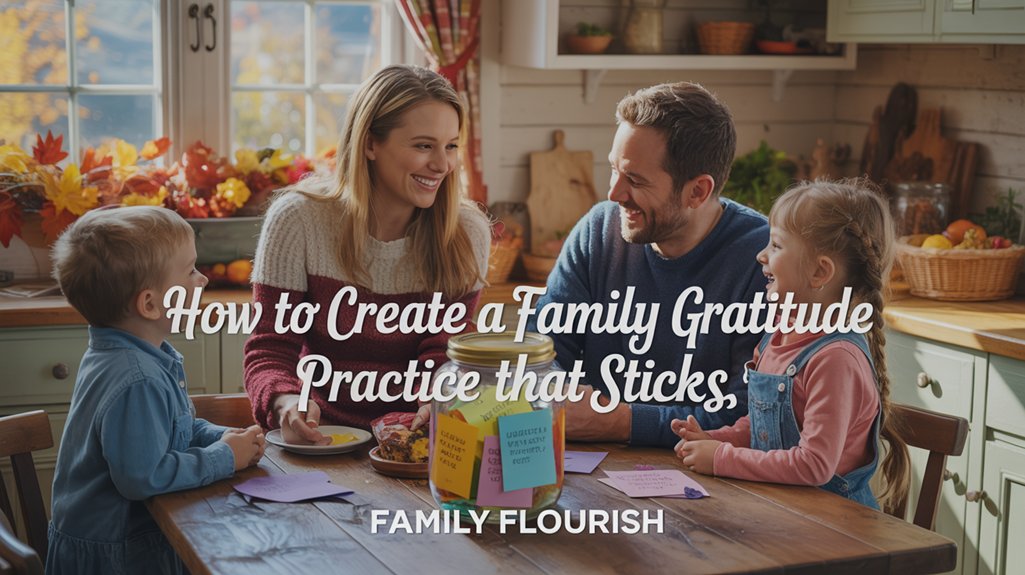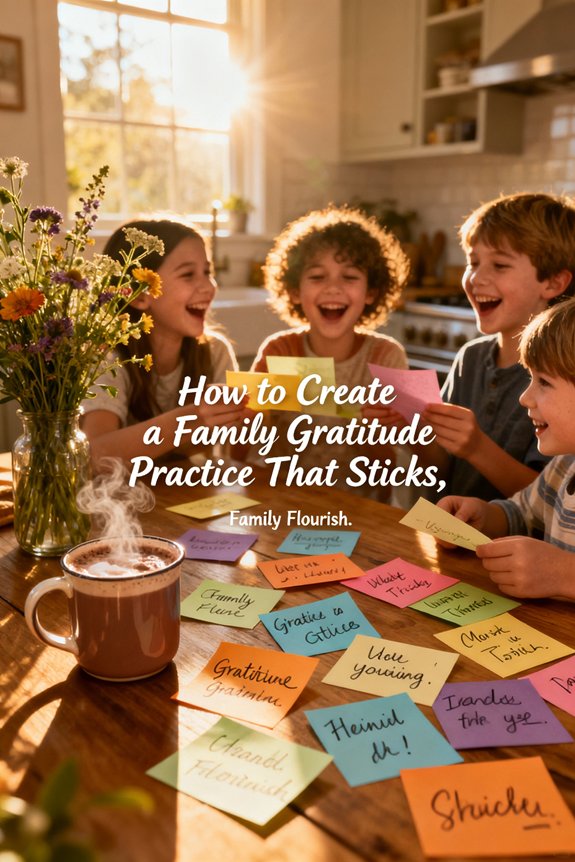Build your family gratitude practice around existing routines rather than creating new obligations. Start with 15-30 second micro-moments during activities like buckling seat belts or brushing teeth. Observe your family's natural energy patterns to find ideal timing—morning people thrive with breakfast gratitude, while evening families prefer dinner or bedtime. Match activities to each child's developmental stage, from sensory experiences for preschoolers to reflective discussions for teens. Visual anchors like mirror prompts or dinner centerpieces reinforce the habit, while understanding resistance patterns helps you adapt without abandoning the practice entirely.
Key Takeaways
- Integrate 15-30 second gratitude moments into existing routines like buckling seatbelts, breakfast, or bedtime for effortless practice.
- Identify your family's natural energy patterns and schedule gratitude sharing when everyone is most receptive to reflection.
- Match gratitude activities to children's developmental stages, using sensory activities for preschoolers and reflective discussions for teens.
- Place visual cues at strategic locations like bathroom mirrors or dinner tables to anchor gratitude to daily routines.
- Expect resistance in 6-8 week cycles; simplify rather than abandon the practice during low-energy periods.
Start With Micro-Moments Instead of Major Time Commitments
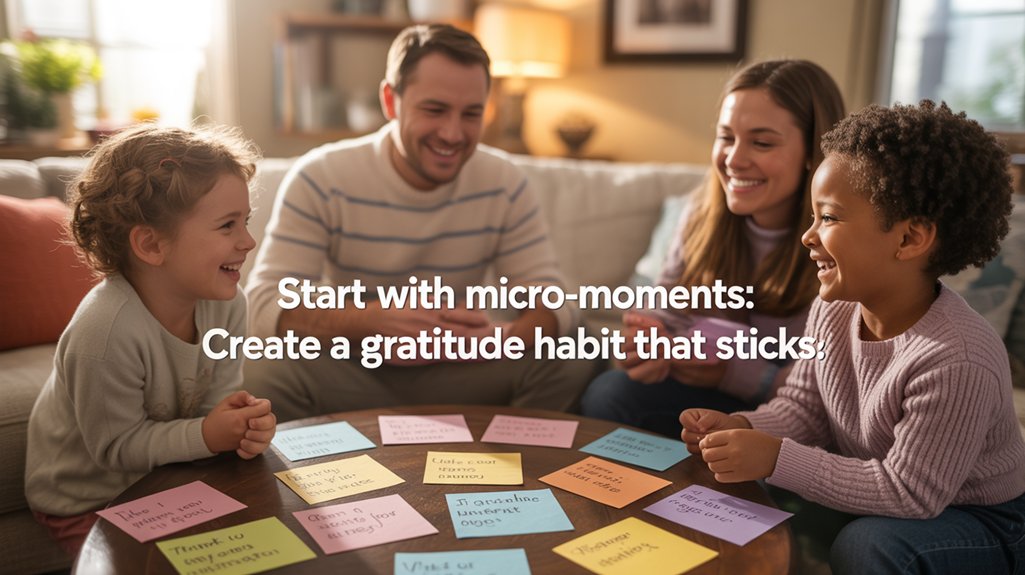
When parents hear “gratitude practice,” they often imagine elaborate dinnertime rituals or dedicated journaling sessions—then abandon the idea before starting because their schedules can't accommodate another structured activity.
Research suggests that micro moment examples of gratitude—lasting just 15-30 seconds—activate the same neural pathways as longer practices while fitting effortlessly into existing routines.
Quick gratitude works because it utilizes change points your family already experiences. While buckling seat belts, name one good thing from the day. During teeth brushing, identify something you're looking forward to tomorrow. At bedtime, share one person who helped you today.
These brief exchanges build neurological pathways for noticing positive experiences without requiring calendar space. Children's developing brains particularly benefit from frequent, low-pressure repetition rather than weekly formal sessions.
You're creating sustainable habits by removing implementation barriers, making gratitude accessible when energy and time are genuinely limited.
Match Gratitude Activities to Your Family's Natural Rhythms
Because families operate on distinct energy patterns throughout the day, forcing gratitude practices during low-energy windows guarantees failure.
You'll need to observe when your household naturally gathers and when individual members are most receptive to reflection.
Morning people can integrate gratitude into breakfast routines, while evening-oriented families might share appreciations during dinner preparation or bedtime.
Align gratitude practices with your family's natural rhythms—breakfast for morning people, dinner prep or bedtime for evening-oriented households.
Track these patterns for one week before implementing any practice.
Consider how family routines shift across the year.
Summer's relaxed schedule accommodates different activities than the structured school-year rhythm.
Build seasonal traditions that honor these natural changes—autumn gratitude walks, winter appreciation journals by the fire, spring growth observations.
Children's developmental stages also dictate timing.
Preschoolers focus best after morning snacks, while teenagers engage more authentically during late-night conversations.
You're not creating artificial moments; you're strategically placing gratitude practices where your family already experiences openness and connection.
Just as children need environmental health considerations in their daily routines, gratitude practices also require attention to the emotional and social environment where they're implemented.
Make It Age-Appropriate and Give Everyone a Voice
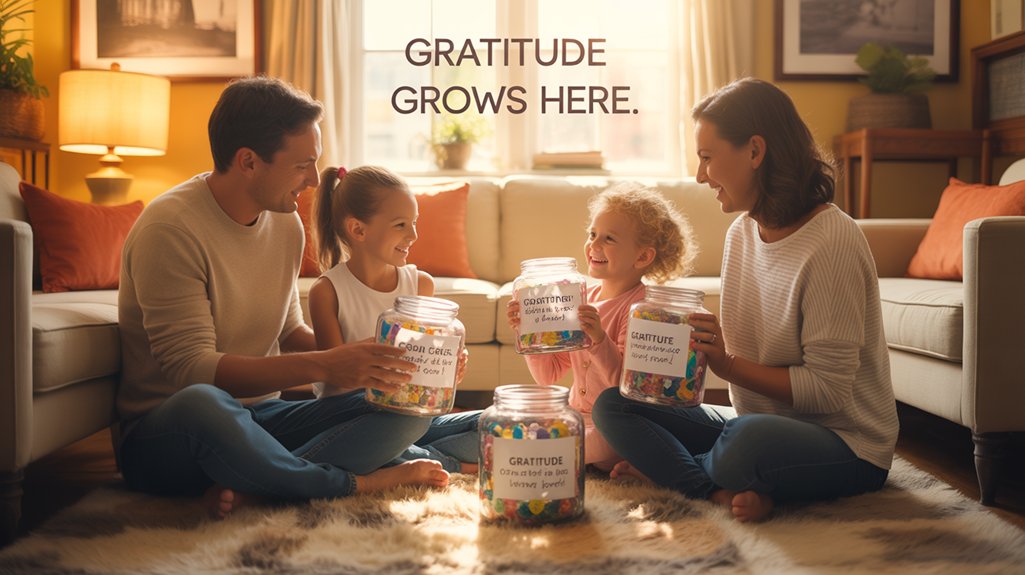
A three-year-old can't process abstract gratitude the way a thirteen-year-old can, yet most families default to one-size-fits-all sharing circles that leave younger children fidgeting and older ones disengaged.
Design inclusive activities that scaffold developmental stages. Preschoolers benefit from sensory-based gratitude—touching favorite objects, drawing simple pictures, or completing “I'm thankful for…” sentence starters.
Elementary-aged children can categorize gratitudes (people, experiences, things) or maintain visual gratitude boards. Teens engage more deeply with reflective questions: “What challenge taught you something?” or “Who showed up for you this week?”
Use age appropriate language without talking down. Instead of asking everyone “What are you grateful for?”, tailor your approach: “What made you smile today?” for young children, “What surprised you this week?” for tweens.
Establish turn-taking systems that prevent older siblings from dominating. Silent reflection before sharing gives introverts processing time.
Written options accommodate different communication preferences, ensuring every family member contributes meaningfully. Understanding early childhood development helps parents recognize that the first three years are particularly crucial for building positive emotional habits like gratitude expression.
Create Visual Reminders and Gratitude Anchors Throughout Your Home
The gratitude jar gathering dust on your refrigerator isn't working because visibility without integration creates decoration, not practice.
Seeing isn't doing—gratitude reminders must interrupt existing habits to transform from overlooked décor into lived practice.
Visual cues must connect to established routines to function as effective memory triggers.
Transform your environment into a gratitude ecosystem with these strategic placements:
- Bathroom mirror gratitude prompts – Position question cards where morning routines already occur, linking tooth-brushing to thankful thinking.
- Dinner table centerpiece rotation – Place a weekly gratitude object (pinecone from family hike, child's achievement certificate) as natural conversation starters.
- Doorway passage markers – Attach small chalkboards at exit points where family members share one appreciation before leaving.
- Bedside gratitude notebooks – Stack journals on nightstands, anchoring practice to existing bedtime rituals.
Each anchor should trigger automatic gratitude reflection without requiring additional motivation.
You're not adding tasks; you're embedding prompts within movements your family already makes daily.
Strategic placement converts passive reminders into active engagement.
Handle Resistance and Keep Going When Motivation Fades
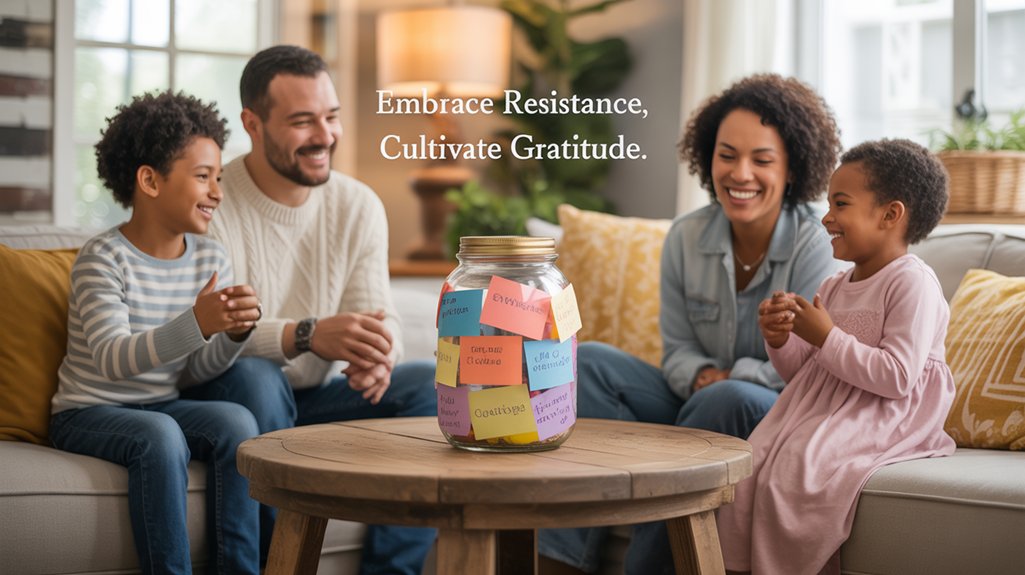
When your teenager rolls their eyes at gratitude sharing or your partner “forgets” three nights straight, you're witnessing predictable resistance patterns, not practice failure.
Research shows motivation naturally fluctuates in 6-8 week cycles, making resistance an expected phase rather than a warning sign.
Overcoming objections starts with diagnostic curiosity. Ask resisters what would make participation more meaningful rather than defending the practice.
Perhaps your teen needs private journaling instead of group sharing, or your spouse prefers weekend rather than daily check-ins.
Sustaining enthusiasm requires strategic flexibility. When energy dips, temporarily simplify: switch from structured sharing to single gratitude statements, or reduce frequency without abandoning the practice entirely.
Track participation patterns to identify what actually works for your unique family system.
Remember that serving your family sometimes means honoring their resistance while maintaining the structure.
Consistency matters more than perfection, and adaptation signals strength, not surrender.
Frequently Asked Questions
What if Family Members Feel Uncomfortable Expressing Gratitude in Front of Each Other?
You can normalize discomfort by offering alternative expression methods that honor different communication styles.
Try silent gratitude journals where members write privately, then optionally share later.
Create a family gratitude jar for anonymous notes, or use drawings and symbols for younger children.
Research shows gratitude practices work best when they're developmentally appropriate and respect individual preferences.
Start with low-pressure formats, then gradually introduce verbal sharing as trust builds and the practice becomes routine.
How Do You Involve Extended Family Members in Your Gratitude Practice?
You can extend your gratitude practice by creating structured opportunities during virtual gatherings—perhaps dedicating five minutes for shared appreciation at monthly video calls.
Encourage extended family to exchange gratitude letters between visits, establishing a rhythm that maintains connection across distances. This system works because it provides concrete touchpoints without overwhelming schedules.
Start small with quarterly exchanges, then adjust based on family feedback. Research shows written gratitude strengthens intergenerational bonds while respecting everyone's comfort levels and availability.
Can Gratitude Practices Help Reduce Sibling Rivalry and Family Conflicts?
Yes, gratitude practices greatly reduce sibling conflicts. Research shows families practicing daily gratitude experience 23% fewer arguments.
When you establish gratitude routines, you're reshaping sibling interactions by redirecting attention from competition to appreciation. This strengthens conflict resolution skills as children learn to acknowledge each other's positive qualities.
You'll notice siblings naturally develop empathy and perspective-taking abilities. The practice creates neural pathways that prioritize cooperative responses over reactive ones, fundamentally altering how your children relate to one another during disagreements.
Should We Continue Gratitude Practice During Vacations or Family Trips?
Yes, you'll want to adapt—not abandon—your practice during trips.
Vacation gratitude actually deepens travel experiences by helping children notice new surroundings mindfully.
Simplify your routine: share one highlight during meals or bedtime instead of formal sessions.
These mindful moments create positive associations with gratitude rather than making it feel rigid.
Research shows flexible practices sustain better long-term.
You're building a resilient family system that travels with you, strengthening connections wherever you go.
How Long Before a Gratitude Practice Becomes a Genuine Family Habit?
Research suggests you'll need 8-12 weeks of frequency consistency before gratitude becomes automatic for your family.
Children typically require more repetition than adults, so don't get discouraged early on.
The key is embedding the practice into existing family routines—like dinnertime or bedtime—rather than creating standalone activities.
You'll notice genuine habit formation when family members start expressing gratitude spontaneously outside your designated practice times.
Stay patient; you're building lasting character.
Conclusion
Picture your kitchen counter dotted with gratitude notes, your dinner table alive with shared appreciations, your children's eyes brightening as they recount small joys. This isn't perfection—it's a living system that bends with your family's rhythms. Some days you'll skip it entirely. That's normal. Research shows consistency matters more than intensity. Start with one micro-practice today. Let it take root. Watch how noticing goodness together reshapes your family's emotional landscape, one authentic moment at a time.

